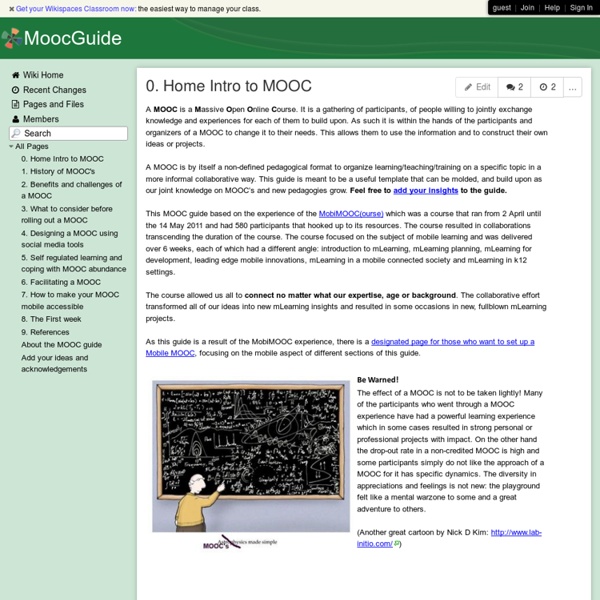



Massive open online course Education service on the web Poster, entitled "MOOC, every letter is negotiable", exploring the meaning of the words "massive open online course" A massive open online course (MOOC ) or an open online course is an online course aimed at unlimited participation and open access via the Web.[1] In addition to traditional course materials, such as filmed lectures, readings, and problem sets, many MOOCs provide interactive courses with user forums or social media discussions to support community interactions among students, professors, and teaching assistants (TAs), as well as immediate feedback to quick quizzes and assignments. MOOCs are a widely researched development in distance education,[2] first introduced in 2008,[3] that emerged as a popular mode of learning in 2012, a year called the "Year of the MOOC".[4][5][6] History[edit] What is a MOOC? Precursors[edit] Early approaches[edit] cMOOCs and xMOOCs[edit] MOOCs and open-education timeline (updated 2015 version)[13][30] Students served[edit]
The MOOC Guide The purpose of this document is two-fold: - to offer an online history of the development of the Massive Open Online Course (MOOC) - to use that history to describe major elements of a MOOC Each chapter of this guide looks at one of the first MOOCs and some early influences. It contains these parts: - a description of the MOOC, what it did, and what was learned - a description of the element of MOOC theory learned in the offering of the course - practical tools that can be used to develop that aspect of a MOOC - practical tips on how to be successful Contribute to this Book You are invited to contribute. In order to participate, please email or message your contact details, and we'll you to the list of people who can edit pages.
Authors: Inge de Waard Inge de Waard is eLearning coordinator at the Institute of Tropical Medicine in Belgium. She organized the MobiMOOC2011 and initiated the MOOCguide. Seamless Learning: Forget MOOCs, Mobile Learning, and Ubiquitous Access November 4, 2013 With so many new training technologies and trends appearing one after the other, we face a major challenge: ensuring a smooth, simple training environment for all our learners. Here’s a look at how to create a seamless learning environment. Check the parts that your training strategy covers and the parts that you can optimize or add. Mobile Learning Supports Global Health May 6, 2013 Mobile technology for healthcare delivery and support—mHealth—is growing rapidly, and mLearning is an important part of it.
Le MOOC, mode d'emploi Le format MOOC (Massive Open Online Course) tend à prendre de l'importance dans l'offre de cours en ligne. Du moins, un nombre grandissant de cours ouverts, gratuits et en ligne sont-ils qualifiés de MOOC. Les récentes initiatives du MIT et de Stanford, que nous avons présentées dans un récent article, sont ainsi assimilées à des MOOC par Christine Cupaiuolo dans un billet publié sur le blog Spotlight. Stricto sensu, ces cours offerts gratuitement à tous ceux qui désirent les suivre relèvent effectivement de la catégorie des MOOC. Mais le MOOC tel qu'il a été envisagé par ses fondateurs et ses plus célèbres représentants, tels qu'il se déploie aussi à la P2P University par exemple et dans nombre d'espaces plus discrets, dispose de caractéristiques qui ne tiennent pas uniquement à son mode de distribution. Le MOOC : gratuit, en ligne, ouvert... et beaucoup plus Un guide pour créer un MOOC - Cette interconnexion généralisée permet la collaboration ou au moins la discussion. MOOC Guide.
Wikiversity Massive Open Online Courses: Setting Up (StartToMOOC, Part 1) by Inge de Waard “Any course consists of some basic features: there is a schedule, a syllabus referring to content and possibly learning actions (assignments, self-assessments…), and there is a learning space where course participants can meet and exchange ideas on the subject of the course to enhance mutual learning and experiences. A MOOC is no different, but because it is online, the course spaces are as well.” Setting up courses in the cloud is a trend in online learning. Whether you are a training company, a non-profit trainer, an experienced hobbyist, or an educational institute, at some point you will want to tap into the cloud, attract new learners from around the globe, and start learning collaboratively. In this first part of a six-part series, you will learn about MOOCs (Massive Open Online Courses), which are courses in the cloud. There are many ways to set up your own cloud course, but sometimes it is nice to have an example to start from. What is a MOOC, or course in the cloud?
Welcome to MOOC.CA ~ MOOC Connexions - Sharing Knowledge and Building Communities Choose and Embed Social Media in Your MOOC (Part 2) by Inge de Waard “After signing up for the social media tools, all you need to do is to link them up to your course. You can do this in different ways. A simple way is to add an icon with a hyperlink to the tool, and add it to the course-wiki welcome page.” Last month, I showed you how to set up the core of an open, online course by using Google groups (for discussing content) and a course wiki (to hold course resources, syllabus, and timing). This month, I’ll show how to add meaningful social media tools that engage participants and increase learning in a MOOC (Massive Open Online Course). I’ll give you a look at what is out there and link it with real life implementation examples. Which tools? The main benefit of incorporating social media in any course is to increase participation and to get participants or learners to engage in conversation. First of all: keep it simple. If you want to add any of these tools, a three-step process suffices to be able to access the tool: Connecting the tool to the course
OER Commons